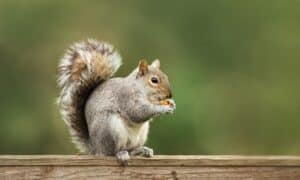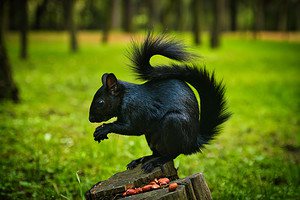Squirrels inhabit almost all corners of the world, making them a familiar part of our everyday lives. But how much do we know about them? Before learning about the nesting habits of these bushy-tailed critters, let’s learn a little more about them.
Squirrels are rodents from the Sciuridae family, which includes nearly 300 different species of squirrels divided into three main subfamilies and tribes – flying squirrels, ground squirrels, and tree squirrels. The name Sciuridae comes from the Greek word skiouros, which means “shade tail”.
Did you know that prairie dogs are part of the squirrel family? In fact, there are many rodents that are also part of this family, including chipmunks, marmots, and groundhogs. This is important to know because each subfamily of squirrel has a different nesting habit to match their environments. In this article, we will talk about each of these three subfamilies and their nesting habits, but mostly focus on tree squirrels, since they are most familiar to us when we use the word ‘squirrel’.
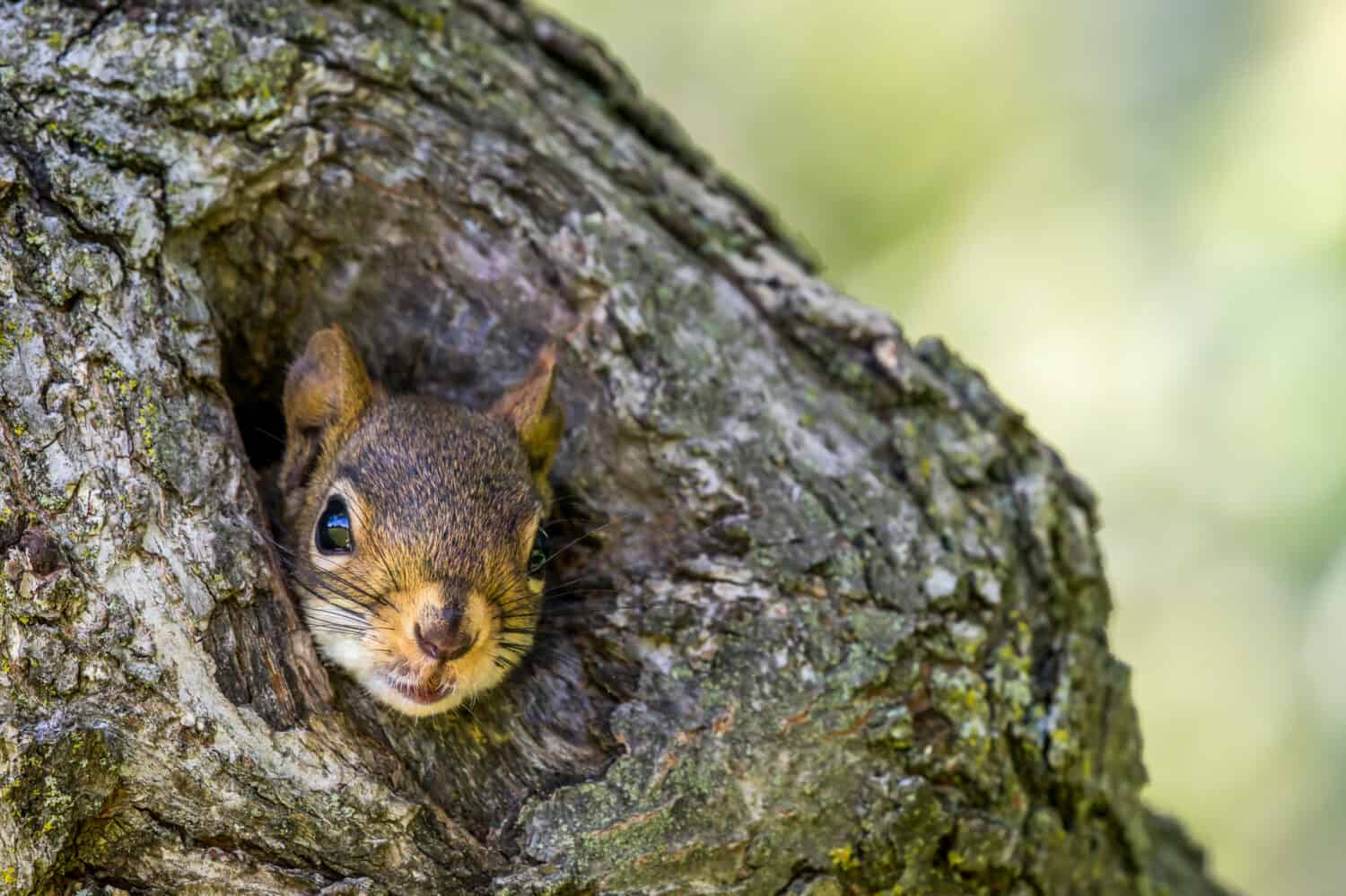
An American Red Squirrel (
Tamiasciurus hudsonicus) pokes its head out of its nest in a tree trunk.
©RT Images/Shutterstock.com
The Three Different Types of Squirrels
First, let’s look at the differences between these three subfamilies.
| Flying Squirrels | Ground Squirrels | Tree Squirrels | |
|---|---|---|---|
| Classification | Subfamily Sciurinae, Tribe Pteromyini and Pteromyina | Subfamily Xerinae, Tribe Marmotini | Subfamily Sciurinae, multiple tribes |
| Distribution | North America, Southeast Asia, Malaysia, Borneo, Indonesia, Finland, Japan, Thailand | Africa, Asia, North America, Europe | North America, South America, Africa, Europe, and Asia |
| Description | Over 50 different species. Large eyes for their nocturnal lifestyle and sleek, slender bodies. | 62 different species, varying in appearance. Named for their nesting habits. | Over 120 different species with varying appearances, all with bushy tails and all tree dwelling. |
| Diet | Depends on species. Omnivorous. Includes nuts, seeds, fungi, pollen, tree sap, insects, spiders, snakes, eggs, small mammals, ferns, flower buds, and lichen. | Omnivorous diet includes fungi, nuts, seeds, berries, insects, eggs, and small mammals, including mice and rats several times their size. | Primarily focused on dry fruit from woody plants, known as mast. Includes tree nuts, berries, and tree buds. |
| Nesting Habits | Rock crevices on cliffs, cave ledges, tree cavities, grottos, and nests built high in trees. | Nesting mostly in self-dug burrows underground, but also make dens in rocky outcroppings and in cavities at the bottom of trees. | High in trees, inside the tree cavities or in nests they build atop high, sturdy branches. |
| Dinstinctive Features | Distinct for the special flap of skin that helps them glide, called a Patagium. They are also unique for being nocturnal. | Can reach larger sizes due to their ground nesting habits. Marmots are some of the largest squirrels. | Uses a mental filing system called “chunking” to sort, organize, and stash nuts and seeds. |
Nesting Habits of Flying Squirrels
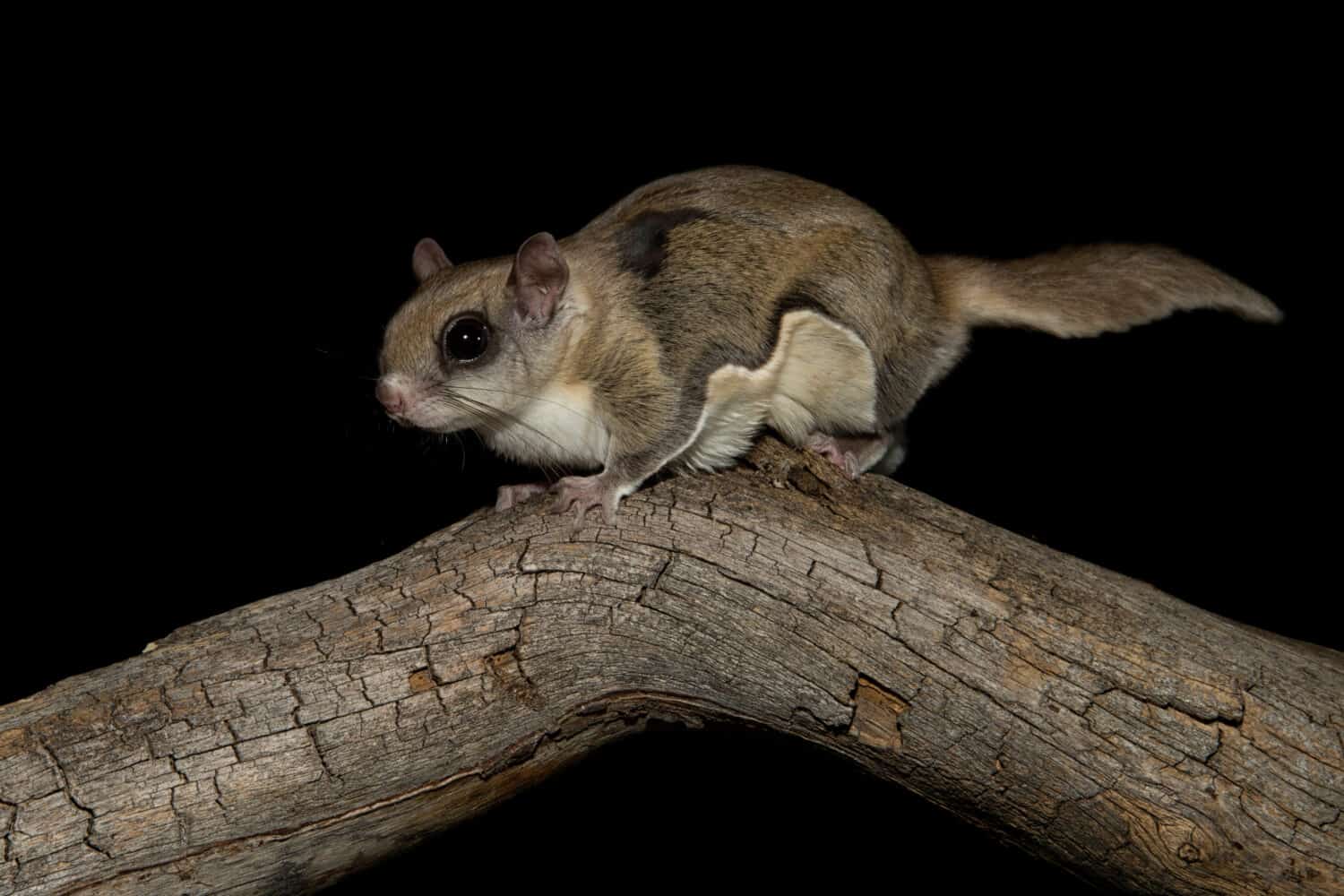
The Southern flying squirrel has a glide distance of up to 49 meters (160 feet).
©Agnieszka Bacal/Shutterstock.com
In the United States, the most common variety of flying squirrel is the Southern flying squirrel – Glaucomys volans. These squirrels inhabit North America from Eastern Canada to Peninsular Florida and as far west as some parts of Texas. Preferring old-growth forests, these nocturnal rodents make their homes in the cavities of trees, especially ones that provide food and are near water sources. Additionally, they seek trees that have already been occupied by other animals. Holes bored by woodpeckers are especially good spots to make a nest, as these hollowed-out spaces are often fifteen feet or more above the ground. A good vantage point is imperative to the survival of this species, as they have many predators, including owls, raccoons, and snakes.
After finding a suitable spot, the squirrels will line their new dens with fur, moss, bark, feathers, and other natural materials. A mother squirrel from this genus will often build a secondary nest to ensure the safety of her young. These mothers also become fiercely protective and will stand their ground when threatened by making loud screeching noises or even attacking the source of the danger.
Flying squirrels are less active in the winter, conserving energy and warmth by sleeping more and nesting together in groups. They are especially active during their breeding seasons, which run from February to April and from August to October. During these times, it is more likely that you will see or hear them calling to each other or gathering materials on a quiet night in the forest. Much like many other squirrel varieties, it is not uncommon for these squirrels to nest in attics or other high, warm spaces when they cannot find a suitable home.
Nesting Habits of Ground Squirrels
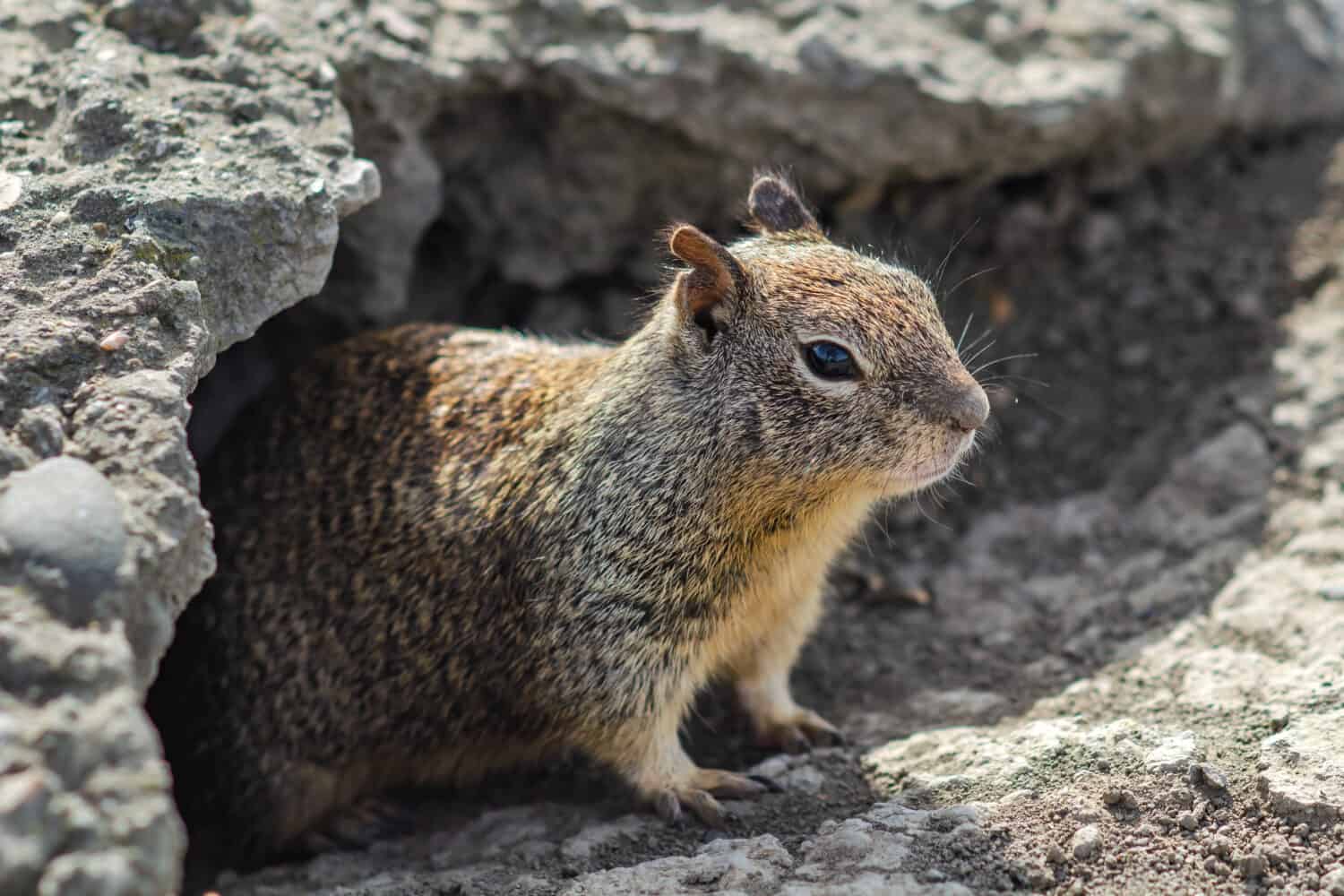
A
California ground squirrel (Spermophilus beecheyi) protects the entrance to her burrow.
©Iv-olga/Shutterstock.com
There are 38 different types of ground squirrels that live in North America. 24 of these types live in the United States. Because of this large number, and the separate nesting preferences of each species, most states have at least one variety of native ground squirrel. For example, much of the Eastern United States is familiar with chipmunks, while many of the more Western states see more activity from marmots. In the plains of Montana and reaching south through the Central states to Texas, prairie dogs make their homes.
Despite their differences in habits and location, the nesting habits of this subfamily are very similar. Ground squirrels, as their name suggests, like to make their homes in burrows they dig in the ground or in crevices found in rocky outcrops. Some squirrels from this family nest on mountains at impressive elevations, but they more often occupy open habitats such as plains, deserts, and prairies. These large, open areas are ideal for the intricate systems of tunnels that the squirrels excavate and occupy. This also makes soft, grassy areas a great pick for their burrows. Some good examples of such places include lawns, pastures, parks, and golf courses.
Ground squirrels do not need to line their burrows, as the wind protection from living underground is enough to shelter them from the cold. When looking for a good place to burrow, ground squirrels will favor areas with slight slopes to protect their homes from moisture. They also prefer to dig under rocks and logs to help protect them from digging predators.
Nesting Habits of Tree Squirrels

A Kentucky grey squirrel perches high above the ground outside a nest she has built into the branches of a tree.
©Rob Dunn Nichols/Shutterstock.com
There are over 120 varieties of tree squirrel. They make up the largest portion of the squirrel family and have the largest range of nativity. Of the numerous varieties of squirrels that exist in the United States, the Eastern grey squirrel is the most common and the most invasive. Native to the Eastern half of the United States, the population of these animals has spread rapidly, and their introduction to western states has created a displacement risk for other native squirrels, such as the American red squirrel. Gray squirrels, red squirrels, and fox squirrels are the most common tree squirrels in the United States, and one or more of these varieties exist in every state. Washington, for example, has four varieties of native squirrel and two introduced varieties.
When choosing a nest, tree squirrels look for oak or coniferous forests. Oak trees are a perfect place to nest due to their widespread distribution and their use as a food source. Tree squirrels in the United States are herbivores and collect most of their food from mast – the fruits and nuts of woody plants. This means that forests containing oak, pine, fir, and spruce are wonderful options as homes for these arboreal mammals.
Tree squirrels build their nests high above the ground, usually at heights of 20 feet or more, out of various natural materials including bark, twigs, fur, and leaves. The nest that tree squirrels build is a “drey“. The squirrel builds its drey in the high-up forks of tree branches or in tree hollows. Squirrels climb to great heights to make their nests, as forks and hollows far above the ground help protect them from predators.
Where to See Squirrels
Of all of the varieties of squirrels in the United States, the hardest to spot is the flying squirrel. Since they are nocturnal, it is hard to see them, but not impossible! The best time to view them is at night, and especially during their breeding seasons. This is when they are most active, giving you better chances at finding them in the wild. Additionally, the largest population in the United States is in Ohio, though you can find them almost everywhere on the eastern side of the country.
Ground squirrels are diurnal and are the only subfamily of squirrel that truly hibernates. The best time to spot them is on warm, sunny days during their active season. California ground squirrels are common and easy to find across the Western United States, but the largest number of ground squirrels exists in Texas, where extensive colonies of prairie dogs make their homes.
Tree squirrels are easy to spot almost everywhere! With an abundance of species spanning every state, you will have plenty of luck locating them. Usually crepuscular, the largest active presence of tree squirrels is at dawn and dusk. However, there are many diurnal tree squirrels that are quite active during the day, as well. Look for them near food sources and forests, and at your local parks! One of the largest collections of squirrels recorded is in Central Park in New York City. In a 2019 squirrel census, a group of volunteers reported 2,373 eastern grey squirrels living in the 800-acre park.
Wherever you decide to go looking, remember to keep a safe distance. Many species of squirrel are struggling to maintain their populations, and disturbances from humans serve to disrupt those populations further. While they aren’t usually dangerous, squirrels can still bite, transmitting disease and parasites.
The photo featured at the top of this post is © Rob Dunn Nichols/Shutterstock.com
Thank you for reading! Have some feedback for us? Contact the AZ Animals editorial team.




